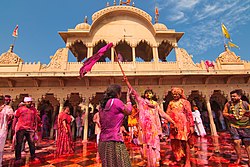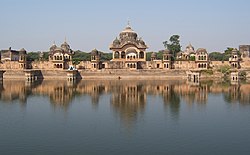
Mathura is a city and the administrative headquarters of Mathura district in the Indian state of Uttar Pradesh. It is located 57.6 kilometres (35.8 mi) north of Agra, and 146 kilometres (91 mi) south-east of Delhi; about 14.5 kilometres (9.0 mi) from the town of Vrindavan, and 22 kilometres (14 mi) from Govardhan. In ancient times, Mathura was an economic hub, located at the junction of important caravan routes. The 2011 Census of India estimated the population of Mathura at 441,894.

Vrindavan, also spelt Vrindaban and Brindaban, is a historical city in the Mathura district of Uttar Pradesh, India. It is located in the Braj Bhoomi region and holds religious importance for Hindus who believe that Krishna, one of the main deities in Hinduism, spent most of his childhood in this city. Vrindavan has about 5,500 temples dedicated to the worship of Krishna and his chief consort, Radha. It is one of the most sacred places for Vaishnava traditions.
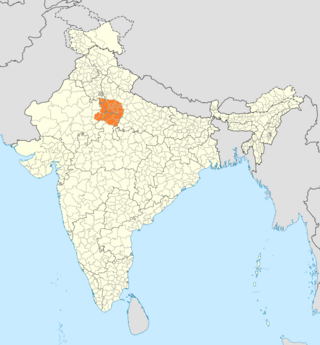
Braj is a language within the Indo-Aryan language family spoken in the Braj region centered on Mathura. Along with Awadhi, it was one of the two predominant literary languages of North-Central India before being replaced by Hindi in the 19th century.
Govardhan also called Giriraj, is a key pilgrimage centre in India and a municipal town; a nagar panchayat; seat of an MLA of Uttar Pradesh; a Tehsil, in Mathura district in India in the state of Uttar Pradesh. About 23 kilometres from Mathura, the town is on the road link between Mathura and Deeg.
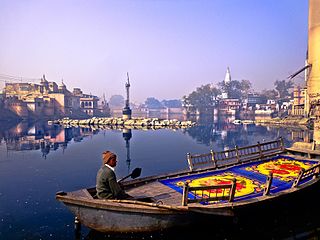
Mathura district situated along the banks of the river Yamuna is a district of Uttar Pradesh state of north-central India. The historic city of Mathura is the district headquarters. Mathura district is home to many important sites associated with goddess Radha and Lord Krishna, who was born in Mathura and grew up in the nearby town of Vrindavan. Both cities are some of the most sacred sites in the Vaishnava tradition, making Mathura district an important Hindu pilgrimage centre.
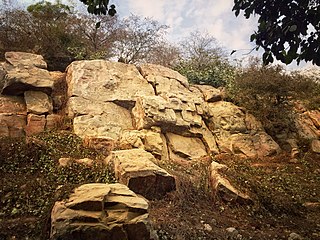
Govardhana Hill, also called Mount Govardhana and Giriraj, is a sacred Hindu site in the Mathura district of Uttar Pradesh, India on an 8 km long hill located in the area of Govardhan and Radha Kund, which is about 21 kilometres (13 mi) from Vrindavan. It is the sacred centre of Braj and is identified as a natural form of Krishna, the Govardhana Shila.

Gokul is a town in the Mathura district of the Indian state of Uttar Pradesh. It is located 15 kilometres (9.3 mi) south-east of Mathura.
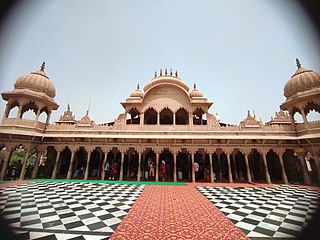
Barsana is a historical town and nagar panchayat in the Mathura district of the state of Uttar Pradesh, India. The town holds cultural and religious significance as the birthplace of Hindu goddess Radha, the chief consort of Krishna. Barsana is situated in the Braj region. The main attraction of the town is the historical Radha Rani Temple which attracts huge number of devotees throughout the year.

Parikrama or Pradakshina is clockwise circumambulation of sacred entities, and the path along which this is performed, as practiced in the Indic religions – Hinduism, Buddhism, Sikhism and Jainism. In Buddhism, it refers only to the path along which this is performed. Typically, in Indic-religions the parikrama is done after completion of traditional worship and after paying homage to the deity. Parikrama must be done with dhyāna.

Radhe Radhe,, also spelled Radhey Radhey, is a Hindi expression used as a greeting and salutation in the Braj region of India. The greeting is associated with the Hindu goddess Radha, who is the consort of Krishna. She is worshiped as the queen of the Braj region, which includes Vrindavan, Barsana, Gokul, Nandgaon, Mathura, Govardhan and Bhandirvan.
Nandgaon is a historical town and a nagar panchayat in Mathura district in the Indian state of Uttar Pradesh. Nandgaon is a religious centre in Braj region.

In Hinduism, the yatra (pilgrimage) to the tirthas has special significance for earning the punya needed to attain the moksha (salvation) by performing the darśana, the parikrama (circumambulation), the yajna, the Dhyana, the puja (worship), the prarthana, the dakshina, the seva, the bhandara, etc. These sacred places are usually located on the banks of sacred waters, such as sacred rivers or their tributaries, the kundas, the ghats, or the stepwells, or the temple tanks.
Vraja Mandal Parikrama, also called VrajaYatra, is a Nimbarka Sampradaya Hindu pilgrimage related to Krishna with the circumambulation At present Vraja Parikrama Pradhan Mahant Sri Sri 108 Swami Rasbiharidas Kathiababaji Maharajji of 84 kos Vraja region (Braja) which takes 1 to 2 months depending on the route and speed of travel on foot. The Nimbarka Sampradaya tradition Vaishnava Nagaji Maharaj only performed 84 crore Vraja Parikrama 530 years ago. Since this is a site associated with the vedic era Lord Krishna and mahabharata, it is an important place of pilgrimage for Hindus. It is one of 3 main pilgrimage sites related to "Krishna" circuit, namely "48 kos parikrama of Kurukshetra" in Haryana state, "Braj parikarma" in Mathura in Uttar Pradesh state and "Dwarka parkarma" at Dwarkadhish Temple in Gujarat state

Yatra, in Indian-origin religions, Hinduism, Buddhism, Jainism and Sikhism, generally means a pilgrimage to holy places such as confluences of sacred rivers, sacred mountains, places associated with Hindu epics such as the Mahabharata and Ramayana, and other sacred pilgrimage sites. Visiting a sacred place is believed by the pilgrim to purify the self and bring one closer to the divine. The journey itself is as important as the destination, and the hardships of travel serve as an act of devotion in themselves.
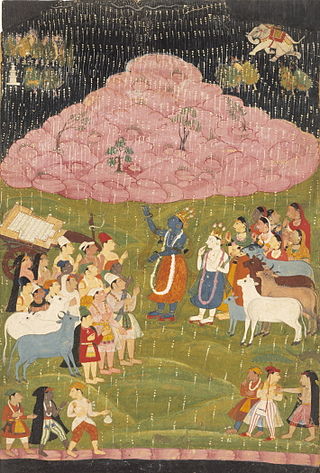
The Govardhana Shila is a rock from the Govardhana Hill in Braj, Uttar Pradesh, India. Govardhan Hill holds a unique position in Hindu scriptures related to Krishna, the land called Braj where He was born. Known as Govardhan or Giriraj and being the sacred centre of Braj, it is identified as a natural form of Krishna. Indian art overwhelmingly prefers the iconic image, but some aniconism does occur in folk worship, early Buddhism, Shiva's Banalinga, and Vishnu's Shaligrama). They have solar significance, and their use in worship predates the Hindu period in India. The stone is usually brown in colour.
Shri Dwarkadhish Temple is a Hindu temple in Mathura, Uttar Pradesh, India. In this historic temple, Krishna is worshipped in his Dwarkanath or Dwarkadhish form along with his feminine counterpart goddess Radha in form of Radharani. The temple belongs to Pushtimarg tradition.

Kusum Sarovar is a sacred water reservoir with a historic sand monument in its backdrop. It is situated on the holy Govardhan Hill between Manasi Ganga and Radha Kund in Mathura district of Uttar Pradesh, India. Kusum Sarovar is considered one of the sacred spots that witnessed the pastimes of Hindu deities Radha and Krishna. It is also the place of Jat ruler Maharaja Suraj Mal's memorial chhatri. Kusum Sarovar has Narada Kund, where Bhakti Sutra verses were written by Narada and the Shri Radha Vana Bihari Temple in the vicinity.
Kotwan is a village in the Mathura district of Uttar Pradesh, India. It is the site where according to Hinduism, Krishna spent his childhood and is one of the main places in the Braj Bhoomi region. The Village is about 100 km away from Agra.

Shri Radha Rani Temple, is a historical Hindu temple, located in Barsana in Mathura district, Uttar Pradesh, India. The temple is dedicated to the goddess Radha. The main deities of the temple are Radha Krishna who are worshipped together in the form of Shri Laadli Lal which means beloved daughter and son of the town.

Radha Krishna Vivah Sthali is a Hindu temple dedicated to Radha and Krishna. The temple site is present in the Bhandirvan forest of Mant constituency in Mathura district, Uttar Pradesh, India. The site holds cultural importance as according to Sanskrit scriptures - Braham Vaivarta Purana and Garga Samhita, Radha and Krishna were married in Bhandirvan forest in the presence of Brahma, the creator, who also became the priest and solemnized their wedding ceremony. Annually, this divine wedding is celebrated on the occasion of Phulera Dooj which usually falls in the month of February - March.


